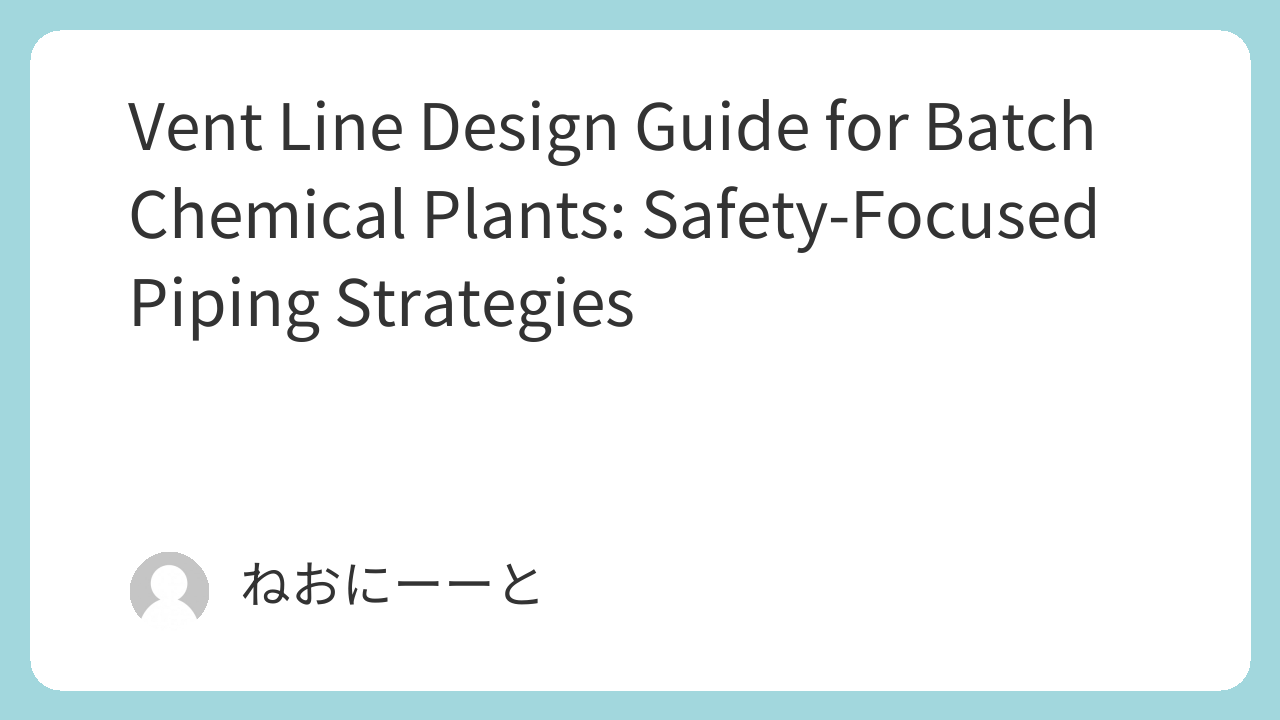Introduction
Vent lines may appear as minor components in piping design, but in batch chemical plants, they are crucial for ensuring safe operation. Unlike regular gas lines, vent lines serve as intentional outlets to release excess pressure or prevent buildup of hazardous gases. Poorly designed vent systems can lead to overpressure incidents or even explosions. This article explains essential design principles for vent lines, emphasizing safety and practical considerations.
Key Design Considerations for Vent Lines
What Is a Vent Line?
In batch chemical plants, a vent line refers to piping that leads from pressure-bearing equipment (e.g., reactors, tanks, heat exchangers) to a safe open-air discharge point. These lines serve to relieve pressure or vent non-condensable gases. Although the term “vent” gained popularity from nuclear power plants, in chemical plants it often refers to the atmospheric release piping from safety valves or gas outlets.
Pipe Diameter
Follow a simple rule: the vent line diameter should be equal to or larger than the largest inlet or outlet pipe connected to the vessel. For instance, if a tank has a 40A inlet and a 50A outlet, the vent line should be at least 50A. This sizing ensures minimal resistance and allows for rapid depressurization.
Material Selection
Common materials used:
- SUS304 (Stainless Steel): cost-effective but less common
- FRP (Fiberglass Reinforced Plastic): widely used for chemical resistance
- Fluoropolymer-lined pipes: excellent chemical resistance but heavy and harder to install
FRP is often preferred for vent lines due to its balance of chemical resistance and ease of installation.
Flange Ratings
Unless otherwise specified, JIS 10K flanges are typically sufficient. Vent lines operate at low pressure, so JIS 5K is often technically adequate—but mixing standards can cause mismatches. Stick to a consistent flange standard across all components.
Routing and Discharge Location
- Keep It Short: Minimize the pipe length to reduce pressure drop.
- Avoid Headers: Avoid combining multiple vent lines into a single header unless vent line remains the main branch.
- Avoid Long Horizontal Runs: These increase pressure loss and should be avoided.
Discharge Point
- Away from the Process Area: Ideally, locate the outlet on the rooftop and outside the production zone to ensure safe dispersion.
- Inside Rooftop Railing: This setup helps capture any mist or liquid droplets from vented gases, preventing environmental contamination.
- Induced Suction: Connect to a centralized scrubber or gas treatment system. In such cases, consider using a flame arrester at the outlet, which also requires periodic maintenance access.
Avoiding Water Seals
Never position the vent outlet inside a drainage ditch. If water accumulates and blocks the vent, pressure buildup can cause serious equipment damage. A partially submerged outlet creates a water seal, defeating the purpose of pressure relief.
Access Ports and Inspection
Install inspection ports on vent lines where crystallization, solid precipitation, or salt accumulation may occur (e.g., with caustic soda or drying equipment). This enables cleaning and ensures continued functionality.
Summary
Vent lines are critical for safe plant operation but are often overlooked due to their low frequency. Proper diameter sizing, material choice, and thoughtful routing help ensure effective pressure relief. Avoid long, complex piping and prioritize accessibility, safety, and simplicity in your design.

Comments